Course:EDCP333/2013Groups/raceracismantiracism
Race, Racism, & Anti-Racism
"Education is the most powerful weapon which you can use to change the world.” - Nelson Mandela
[[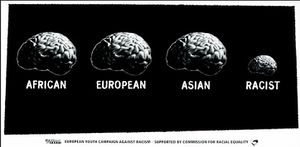 | |
|---|---|
| EDCP 333 | |
| Section: | |
| Instructor: | |
| Email: | |
| Office: | |
| Office Hours: | |
| Class Schedule: | |
| Classroom: | |
| Important Course Pages | |
| Syllabus | |
| Lecture Notes | |
| Assignments | |
| Course Discussion | |
EDCP 333 Wednesday Group Members and Lesson Plans
- Mitch Zwirn: mitch_zwirn00@hotmail.com:
Residential School Lesson Plan: https://docs.google.com/document/d/1lekhI4ohbc7loaSWnGE5RnJ7J1YWJgv4oVD5AhjdEAg/edit
- Nicholas Tan: nickzetan@gmail.com
Primary documents + Komagata Maru/Head Tax Lesson Plan: https://docs.google.com/document/d/17yq2vjp35wvWo6KL0VpKqEfV5hZqi0099ETnCt3iMfg/edit?usp=sharing
- Alycia Blair: alyciablair7@gmail.com:
Internment of Japanese Canadians:https://docs.google.com/file/d/0B0S4MmzAh26KRFZSaE1EQWVwTlU/edit
Racism & Anti-Racism Workshop- November 20th 2013
Readings To Be Read For Workshop
“Gumbo and menudo and the scraps of citizenship” (Brown & Urrieta)
- Taking a look at the theoretical lenses of racial contract theory and interest convergence and how that affects citizenship
- Racial contract theory: democratic societies are spaces where white males regulate, control, and define the standards of society. Therefore, whites as a group become privileged whereas everyone else comes under their subordination and exploitation and are denied opportunities. (p.66)
- Interest convergence: Historically, when white interests aligned with those of the "Other," the racial contract would alter. However, it would only alter to the extent where white benefits outweighed those gained by the other minority groups. Derrick Bell argues that the advancement of racial rights only became a priority when this converged with the ideological and economic interests of whites. (p.66)
- Throughout history we have seen that a true citizen is that of a white, heterosexual, landowning male. Everyone else is not a citizen or only conditionally one. There is a sense of a "dual reality of citizenship" for these minority groups. Brown and Urrieta state that when these minorities, such as African Americans and Mexican Americans, speak out on injustices they are discriminated against. Add in the limiting resources to stop this and many communities will "sign" and "abide" by this racial contract on the belief that they will gain better resources such as education and housing in order to change their reality. (pg.79-80)
‘’’We cannot be color-blind’: Race, antiracism, and the subversion of dominant thinking” (Dei)
- There are various challenges we face as educators: For one it is that we cannot hide difficult and important issues of our society in the classroom. As educators, we have come to learn the importance and benefits of confronting controversial issues such as race, but also issues of sexism, class, and globalization.
- Many teachers have claimed to not see colour in classroom, or to be "colour-blind" but this is problematic. We need to recognize different colours and races of students because it directly affects their privilege or disadvantages that are built by society. Being colour-blind continues the path of naivety and not addressing a problem that had the potential to be fixed.
- "Education is a force to be reckoned with." (Pg.30) Shows that as teachers we can implement a change to how societies view race and it starts in the classrooms buy not being colour blind. An part of Dei's article is that difference is more valuable and important than sameness. Why can't we acknowledge difference and learn form it rather than trying to believe everyone to be the same.
- Sometimes power can be used in schools to create problems for minority races and because of the way our curriculum is, this can occur a lot. Furthermore because of the curriculum, various minorities races are not receiving attention or being learned about in Social Studies classes. For example, there is little mention of African Canadian history in schools across Canada. By not teaching it, the problems and racism associated with these minorities groups are not being learned.
- Dei's article concludes with an optimistic outlook: if we challenge the status quo and the grand narrative curriculum and fight endlessly, we can defeat racism in our classrooms. As teachers we must not just teach these students, we must also assist them in their educational experience as a whole and make learning possible and enjoyable for them.
“White supremacy and the rhetoric of educational indoctrination: A Canadian case study” (Stanley)
- Stanley writes about how the education sysem in BC during the early 1900s helped perpetuate notions of racism and imperialism. This in turn creates the "other" which establishes a racial hierarchy that promotes White supremacy.
- Students are taught race concepts to justify social and political treatment of different racial groups, such as Whites, Asians, and First Nations.
-Moreover, the school system itself is used and manipulated to serve racist ideologies and promoting White supremacy by segregating students based on race, and "insulated White students from non-Whites, thus facilitating [students'] indoctrination in the ideologies of dominance: imperialism and racism" (Stanley 114)
-BC textbooks taught students about the moral greatness of British imperialism, and how it has the capabilities and moral strength to civilise the "savages". Textbooks also illustrate the effects of British imperialism by contrasting a painting of a "civilised Indian girl" and a "non-civilised Indian girl". This would give the impression to its young readers that British imperialism is helping the "savages" by imposing modern White culture and dress codes.
- Stanley provides an example of an elementary textbook authorised for use in BC between 1911 and 1923. The textbook chapter on "races of mankind" describes the different races of the world, in which it describes "The White Race" as "the most active, enterprising, and intelligent race in the world." Thus Whites become established as the positive norm against which other races could be evaluated. (Stanley 123)
Racism & Anti-Racism Workshop Lesson Plan
The PowerPoint Presentation for our workshop: https://docs.google.com/presentation/d/1uVWfjDB4e_O2QbcwF-sQhAo0aQYpgUd4fqjIrWPtGoQ/edit#slide=id.p
1) Hook: The Effect of Racial Stereotypes Activity- 25 Minutes
2) "Racism in Vancouver" PowerPoint Presentation- 10 Minutes
3) Cultural Bag Activity- 10 Minutes
4) "Racism on a Larger Scale" PowerPoint Presentation W/ Picture Analysis & Video- 15 Minutes
5) Paired Discussion Questions Activity- 15 Minutes
6) Conclusion: Final Questions & Video- 15 Minutes
7) Handout on Combating Racism in the Class
Total Time: 90 Minutes
Potential Discussion Questions
- Is it racist to use the term "White" to describe European Americans?
- Is it racist to use the term "non-White" to describe people of color?
- Can people of color be racist?
- Although many people are quick to detect and condemn instances of racial prejudice, White privilege often goes undetected. What explains this difference?
- What is the difference between equal opportunity and affirmative action? Do the two policies contradict each other?
- If affirmative action is to continue, should its main goal be to remedy past discrimination, correct current unfairness, promote diversity, or something else? (Note: Its implementation may vary by goal.)
- Is it racist for athletic teams to use names such as the Indians, Braves, and Redskins? If not, would it be okay to use team names such as the Hispanics, Chinamen, or Blackskins?
- If it is racist for athletic teams to use names such as the Indians, Braves, and Redskins, is it racist to watch their games?
- Do you support or oppose the idea of racial profiling (for example, greater scrutiny of Arab passengers) in airport security?
- If profiling on the basis of race is wrong, is it also wrong to profile on the basis of gender? For instance, is it wrong for a woman walking alone to take greater protective measures when encountering a male stranger than a female stranger?
- In cases of adoption, should agencies try to match the race of children and parents, or should adoptions be carried out in a race-blind manner?
- Is it wrong to have an all-Black student dormitory? What about an all-White dormitory? Does the answer depend upon minority-majority status?
- What is the ideal degree of integration to have in society? Is the same ideal shared by people of all races?
- Does the existence of Black, Latino, and Asian student groups combat racism, reinforce separatism, both, or neither?
Racism Workshop Video
History of Racism in British Columbia
lndigenous Issues
Since the arrival of Europeans in North America, indigenous peoples have faced great amounts of racism and discrimination. Early in Canada's history, the infamous Indian Act was created in 1876. The Act allowed the government to control every aspect of Aboriginal life in Canada. Aboriginal rights were disregarded for the government's belief that the Indian Act would benefit Canada. Along with their loss of rights, residential school systems were created across Canada.[1]

B.C. Residential Schools
The Residential school system was developed as a method to "Beat the Indian out of the Child."[2] The Canadian government implemented residential schools across Canada as a way to assimilate the Indigenous population of Canada to the standards of the European immigrant populace at the time. Religious institutions were heavily involved in the process, The Anglican Church and Roman Catholic Church implemented various nuns and priests to implement teaching to indigenous people. [3] Under these "teachers" students were forced to give up their personal beliefs and culture and forced to assimilate to a culture they did not want. Living conditions at various residential schools were extremely poor, children were abused, raped and even died at these schools. Claiming they were doing good, the Canadian government and residential school system only created detrimental effects to indigenous people.
The horrors of the Residential school system are still being discovered and more indigenous people are coming forth to tell their story. The Residential School system is a more notable event in British Columbia's racist history. Councils such as the Truth and Reconciliation Council are being created to bring justice to all those effected.[4]
Current Sources: "Former residential school teacher opens up about reconciliation"- CBC
"Victim of residential schools recalls abuse as Reconciliation Week begins"- The Province
Chinese Head Tax
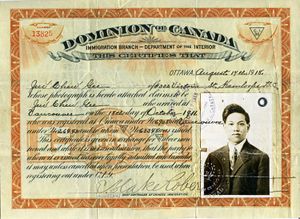
Chinese immigrants to Canada began in 1858 with excitement for the gold rush in BC. However, many Chinese men were came to Canada prior in order to build the Canadian Pacific Railway. The white population began to fear that these immigrants would take their jobs and make their residence permanent by bringing their families.[5] With the completion of the CPR, the government began to restrict the access of Chinese immigrants to Canada. In 1885, Canada introduced the Chinese Head Tax. It stipulated that Chinese immigrants had to pay $10 in order to land in Canada. In 1900 the head tax was increased to $100 and in 1903 to $500. Those already in Canada were denied full citizenship. By the end, the Canadian Government collected $23 million from the Head Tax.[6] BC was the largest recipient of proceeds from the head tax.[7] It was not until June 2006, that an apology was given and the history called a "grave injustice."[8] Despite the large sum to enter the country, many immigrants still arrived. This led the government in 1923 to pass the Chinese Immigration Act, excluding most Chinese immigrants from entering Canada. Between 1923 and 1947, when the act was repealed, less than fifty immigrants were allowed in. [9] The impact of these acts was devastating for families as many remained a part from one another for long periods of time. In addition to these Acts, Chinese immigrants faced much discrimination. In BC in particular, there were Anti-Asian Riots. In 1907, an anti-immigration rally of 4,000-8,000 erupted into violence and vandalism in Vancouver's Chinatown and Japantown. These riots began in Bellingham, Washington as a means to drive Sikhs out of the logging industry and evolved in Vancouver to a white supremacist march with demands for a "White Canada."[10]
Current Source: "Sid Chow Tan: His grandfather paid the Head Tax" - The Province Newspaper
Komagata Maru

The Kamagata Maru was an infamous incident of Racism in Canadian history. The incident involving the passengers of the Komagata Maru occurred in 1914. The ship was carrying 376 refugees from India; of these 376 passengers, 340 were Sikh, 24 were Muslim, and 12 were Hindu. The Ship arrived at Vancouver's shore with it's passengers hoping to start a new life. Many felt threatened by the arrival of anyone who was 'non-white' and did not want these refugees living in Vancouver. Due to the prejudice and racism of those living in Vancouver at the time, the passengers were not allowed to enter Vancouver and were turned around. More misfortune came to the passengers of the Kamagata Maru. Upon returning to India, the Komagata Maru faced new problems. British officials tried to control the passengers to board their ship again and the frustrated passengers refused. Due to their refusal, British officers opened fire and killed twenty passenger and injured nine others.[11] The problems faced by the passengers of the Komagata Maru could have been avoided if they were accepted in Vancouver.
Current Source: "Jaswinder Singh Toor: His grandfather was aboard the Komagata Maru" -The Province Newspaper
Japanese Internment
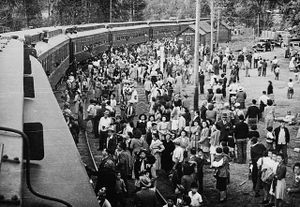
During the Second World War on December 7, 1941, Japan attacked Pearl Harbour in the United States. Despite the opposition of senior members in the Canadian military and the RCMP, over 21,000 Japanese Canadians were quickly relocated from their homes for the purpose of "military necessity." This was done under the War Measures Act in 1942. Many men were sent to work in road camps in Ontario and on the border of BC and other were sent to various small inland towns to stay in internment camps. Even though Japanese Canadians were told their property would remain intact, the Custodian of Enemy Alien property sold their property to cover the wages of auctioneers and realtors, as well as for storage and handling fees. In order to prove their loyalty to BC, Japanese Canadians were encouraged to move out of BC or sign an agreement to be sent back to Japan at the conclusion of the war. Many in fact did move to other provinces and 4,000 (half that were Canadian born) were exiled to Japan after the war. On April 1, 1949, Japanese Canadians were finally given full citizenship rights, including the right to return to their homes that were no longer in their possession.[12] The lives of Japanese Canadians were forever changed as many lost pride in their heritage. They continued to struggle to find a place in BC's society always fearing racial discrimination. With new immigrations laws created in 1967, an influx of Japanese people came and revitalized many of the communities. From this influx, a movement began in the 1980s to redress the issues they faced during the war and to seek an apology and compensation for the injustices committed. In September of 1988, under Prime Minister Brian Mulroney, redress was achieved and Japanese Canadians became an example for minorities and their struggles against racism in BC.[13]
Current Source: "Mary Ohara: She spent her early teen years in an internment camp" - The Province Newspaper
Hogan's Alley
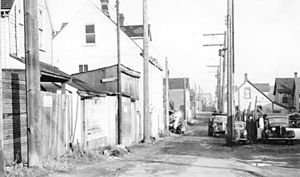
During the post-war era's automobile boom, many lower class and immigrant neighbourhoods were destroyed. In particular, Hogan's Alley in Vancouver's Eastside. Located in between Union and Prior Street near Chinatown, this small area was home to the few black families living in Vancouver. It also consisted of Italian and Asian immigrants. [14] There were no laws segregating blacks in Vancouver, as there were for others, but many families lived here because they believed they did not fit anywhere else.[15] In the 1970s this diverse community was cleared out and destroyed in order to build the Georgia Viaduct. To the elite in Vancouver this neighbourhood was seen as an area filled with "squalor, promiscuity, and crime." Life for many of the people living in this area was one of culture, religion, and good times. Most importantly, was the first black church founded by Nora Hendrix, the grandmother of Jimi Hendrix. In 1956, the Canadian government under the National Housing Act was able to promote the destruction of buildings on valued land in order to ensure it was used efficiently, virtually ignoring the social and cultural value of the area. [16]
Current Source: "Anthony Brown: His father's Vancouver neighbourhood was replaced by viaducts" - The Province Newspaper
Different units in Canada where Black Canadian history can be taught: http://blackhistorycanada.ca/teachers.php?id=1
Looking at Minority Groups (the "Other")

Their experiences and narratives
RCMP Staff Sgt. Baltej Singh Dhillon was the first Royal Canadian Mounted Police Officer to be allowed to wear a turban on active duty.
He related his experiences growing up in an interview conducted by The Province. He immigrated to Canada from Malaysia in 1982, and as a new immigrant who wore culturally different forms of clothing, he was subjected to constant racial abuse and taunts in school and in the neighbourhood. Consequently, he recounted how he never felt Canadian throughout his youth until he was accepted into the RCMP.[17]
Even so, the RCMP regulates that all officers on duty must be clean shaven and in full uniform including the issued head gear. This conflicted with Dhillon's Sikh religion which required a beard and wearing a turban. Thus, despite meeting all the entrance requirements, Dhillon was kept off the force until the issue with head gear was resolved. Dhillon's fight to maintain his right to freedom of religion without any discrimination based on race and religion generated a lot of heated debate and protest across Canada. Many felt that tradition was being sacrificed to accomodate one person, and others argued that the Canadian Charter of Rights supported Dhillon's request. After several months on 15 March 1990, the federal government finally permitted Dhillon to wear his turban whilst on active duty. Dhillon began police training at the academy in Regina and graduated in 1991.[18]
Race Issues in the B.C. Education system
White Privilege
The concept of white privilege refers to an inconspicuous set of privileges that white people are argued to have over people of other races in the same social, economic, political arenas. White privilege revolves around the notion of normalcy and the assumption that a white person's experiences are universal and normal, marking the experiences of people from other races as different. The noted subtlety of white privilege, makes it relatively hard for individuals to be aware of such privileges.As such, white privilege can arguably be seen as an unconscious act of oppression.[19]
American feminist and anti-racist activist Peggy McIntosh wrote: "As a white person, I realized I had been taught about racism as something which puts others at a disadvantage, but had been taught not to see one of its corollary aspects, white privilege, which puts me at an advantage."[20]
- "Antiracism challenges White power and its rationality for dominance. It is about resisting colonial and neocolonial privileges." (Dei 29)
Colour Blindness Regarding Teachers
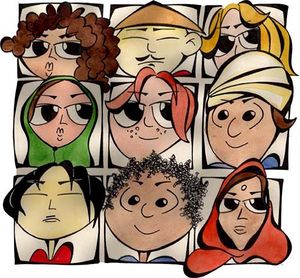
- Many teachers believe that being colour blind in their classroom will help their students by not recognizing difference amongst them. This view has good intentions but as mentioned, is problematic. It is problematic due to the harsh reality that these students will be judge on their race through out their lives. Furthermore, some students, such as white students will have more opportunities and easier access to certain jobs than others because society is not colour blind, nor will it change to jusge people solely on their capabilities rather than their physical appearance.
- So as teachers, it would be most beneficial to acknowledge difference race and ethnicity in the classroom and celebrate it. People are different and their colour has a lot to do with their differences. Having a diverse class is a beneficial thing and provides teachers with great opportunities to teahc their students about diversity and difference amongst people.
- Students are different and we need to acknowledge that.
Victim Blaming
- "A blaming-the-victim mentality is cultivated and rewarded to avoid implicating larger systemic and structural forces of society" (Dei 27)
In the book "Blaming the Victim", William Ryan argues that victim blaming is an ideology used to justify racism and social injustice against minority races especially African Aemricans. Thus, blaming the victim essentially perpetuates the social injustices that African Americans face, since the onus to correct the injustices is pushed onto the victim, not the oppresor.
Differential Treatment by Race
"African American children are not afforded the same treatment as European American children, and consequently never enjoyed the benefits of adolescence because they are viewed differently by white society." Kevin B. Nunn
The differential treatment of racial minorities especially African American teens in the United States' judiciary system. Nunn argues that teens belonging to distinct minorities are treated much harsher by the judiciary system than white American teens. He claims that there is a higher probability for African American, Latino American, and Native American teens to be charged as adults along with a harsher penalty. This differntial treatment of race by the judiciary system, thus creates the "other" from which it becomes a tool to define oneself and the reality with which the self engages.
This famous eye colour experiment shows students how it feels to be discriminated on based on their physical appearance
Also See: A Class Divided - PBS It is about an Iowa schoolteacher who, the day after Martin Luther King Jr. was murdered in 1968, gave her third-grade students a first-hand experience in the meaning of discrimination. This is the story of what she taught the children, and the impact that lesson had on their lives.
Lack of Curricula and Pedagogic Diversity
Many students will identify themselves by their race but if one looks at the IRPs there are barely any objectives that touch on ethnicity and none that actually use the word "race." However, there is a large focus in a lot of the curriculum on First Nations but even then the big issues are not discussed. For example, in the Grade 10 textbook Horizons there is one sentence on residential schools in the conclusion of a chapter. If you take a look at the assigned textbooks for Social Studies there are few mentions of racial issues and when race is brought up it is laid out in a separate small section such as the underground railroad or immigration. If teachers do not go beyond the curriculum and textbook students will never hear about Africville in Nova Scotia or the exploitation of immigrants in our Canadian history or even that one of BC's black settlers, Mifflin Wistar Gibbs attended the Yale Convention in 1868 and gave his support for joining Confederation. Orlowski points out that "the IRPS ignore the impact the white-supremacist attitudes had on imperialism, colonialism, and Canada's nation building project. As a result, their role in influencing the social relations in BC today cannot be understood. This is not an insignificant oversight. The result is that too little is done to challenge" dominant Canadian values. [21]
Aboriginal Education In BC Today
Curriculum & Lesson Plans
In the B.C. Curriculum
Looking at and critiquing the various IRPs, there is really not much mentioned of racism in Social Studies in British Columbia. The set curriculum tends to very much gloss over a lot of vital issues in the history of not only Canada but the world. There is plenty of opportunity to talk about and teach these issues throughout the high school grades. Teachers will just have to take the initiative and teach it themselves. The course Social Justice 12 is a course that has potential to really cover issues of racism that would be important to learn. Here students will have a lot of opportunities to learn about race, racism and anti-racism. In courses like History 12, racism can be implemented into the unit on the Holocaust. In Canada's racist and discriminatory history, the treatment of Aboriginals throughout Canadian history can be taught as well as the other racist events that arose with those who were not white during Canada's history. So there is definitely a lot of material to teach with, it is just no where to be found in Social Studies curricula.
Social Justice 12
Social Justice 12 is new course in British Columbia. Implemented in 2008, the course focuses on social justice issues and our topic: racism.[22] Social Justice 12 aims to raise student's awareness over issues such as racism and human rights, to teach them about it and how they can positively change the world. This class is extremely valuable for all students in British Columbia. Living in B.C. we deal with many diverse ethnicities every day and deal with social justice issues everyday.
The IRP for Social Justice 12 can be found here: "Social Justice 12 IRP" -BC Ministry of Education
PLOs
Various PLOs from Social Justice 12 that relate to our topic of Race, Racism and Antiracism are as follows:
- A1: Demonstrate understanding of concepts and terminology of social justice, including anthropocentrism, equity and equality, ethics, diversity, dignity and worth, hegemony, human rights, oppression, peace.
- B1: Describe social injustice based on characteristics including age, marital or family status, mental or physical ability, political belief, race and ethnicity, religion and faith, sex, sexual orientation, socioeconomic status.
- B3: Describe consequences of social injustice.
- B4: Analyse specific examples of injustice in Canada related to characteristics such as age, marital or family status, mental or physical ability, political belief, race and ethnicity, religion and faith, sex, sexual orientation, socioeconomic status.
- B5: Analyse the roles played by legislation, the courts, public policy, and other forms of government action in promoting or failing to promote social justice in Canada.
- B7: Assess the contributions of particular individuals and groups who are identified with struggles for social justice.
- C2: Apply systemic analysis to propose solutions to specific cases of social injustice.
- C4: Assess lifelong opportunities related to social justice.
Sample Lesson Plans
- "Racism In Canada" -BCTF
- "Immigration Information and Critical Thinking Activities"- BCTF
- "Residential School Sensitive Issues Lesson Plan"- Indian Residential School Resources
- "The Roots of Residential School Racism"- Indian Residential School Resources
- "Indian Residential Schools"- The Historical Thinking Project
- "Japanese Internment Lesson Plan"- Japanese Canadian History
- "Chinese Canadians: The Wong Kung Lai and Chu Man Ming Family" - Historical Thinking
- "Cold Case History Files - The Case of the Scottish Nightingale" - Historical Thinking
- "Who Killed WIlliam Robinson? Race, Justice, and Settling the Land" - Canadian Mysteries
Classroom Strategies
How to Deal with a Student who makes a Racist Remark
The New Teacher Book provides a great example of how to deal with a student who makes a racist remark.[23] Instead of punishing the student or telling them that they should not say racist things. As teachers we need to confront the issue immediately and educate the class about racism and certain prejudice remarks. Through education we can help get rid of any racist views that students may have. teachers must remember that everything that occurs in their classroom is part of the curriculum. Learning about racism and anti-racism is perfect for building outstanding Canadian citizens.
The Topic of Racism and Standardized Tests
Bill Bigelow addresses how in Oregon the "R" word is missing from the curriculum standards and tests. It is odd since race issues are such a large and important part of Oregon's history and many other places', especially BC's, history. that "there is no way that students can make sense of the world today without the idea of racism in their conceptual knapsack. If a key goal of multiculturalism is to account for how the past helped shape the present, and an important part of the present is social inequality, then standards and tests [...] earn a failing grade." [24] It could be vital to bring up these issues within the classroom and get meaningful and critical discussions started.
More Resources on Race, Racism & Anti-racism
- "Racism in Paradise" -The Province Newspaper
- "Canada Racism" -The Huffington Post
- "Contesting White Supremacy: An interview With Timothy J. Stanley" -Active History
- "B.C. Residential Schools"
- "In the Shadow of Gold Mountain" - Karen Cho (NFB)
- "Komagata Maru Journey" - SFU Library
- SEDAI: The Japanese Canadian Legacy Project
- "Enemy Alien" - Jeanette Lerman (NFB)
- Hogan's Alley Memorial Project
- Black Pioneers of BC - Crawford Kilian
- Antiracism - BCTF
- Ways to Challenge Racism - BCTF
- 10 Ways to Educate for Antiracism and Celebrate Diversity - BCTF
- EmbraceBC - Tumblr Blog
- Anti-Racism Resource Centre
- Özlem Sensoy's Books and Papers
References
- ↑ http://indigenousfoundations.arts.ubc.ca/home/government-policy/the-indian-act.html#whitepaper
- ↑ http://www.danielnpaul.com/IndianResidentialSchools.html
- ↑ http://indigenousfoundations.arts.ubc.ca/home/government-policy/the-residential-school-system.html
- ↑ http://www.theprovince.com/news/Victim+residential+schools+recalls+abuse+Reconciliation+Week+begins/8905867/story.html
- ↑ http://www.library.ubc.ca/chineseinbc/headtax.html
- ↑ http://www.ccnc.ca/redress/history.html
- ↑ http://www.roadtojustice.ca/laws/chinese-head-tax
- ↑ http://www.library.ubc.ca/chineseinbc/headtax.html
- ↑ http://www.ccnc.ca/redress/history.html
- ↑ http://www.library.ubc.ca/chineseinbc/riots.html
- ↑ http://www.vancouverhistory.ca/archives_komagatamaru.htm
- ↑ http://www.japanesecanadianhistory.net/the_war_years.htm
- ↑ http://www.japanesecanadianhistory.net/rebuilding_and_revival.htm
- ↑ http://spacing.ca/vancouver/2013/08/12/the-end-of-hogans-alley-part-1/
- ↑ http://ubyssey.ca/features/colours-hogan%E2%80%99s-alley-and-black-vancouver/
- ↑ http://spacing.ca/vancouver/2013/08/12/the-end-of-hogans-alley-part-1
- ↑ http://www.theprovince.com/news/racism/index.html, Baltej Dhillon.
- ↑ http://asia-canada.ca/asia-pacific-reality/wisdom-diversity/creating-change-baltej-singh-dhillon
- ↑ Peggy McIntosh. 1989. "White Privilege: Unpacking the Invisible Knapsack", Peace and Freedom
- ↑ Ibid.
- ↑ http://blogs.ubc.ca/ssed317/files/2008/08/orlowski-ss-in-bc.pdf p.93
- ↑ 'http://www.bctf.ca/SocialJustice.aspx?id=17508
- ↑ The New Teacher Book 2nd Ed. Ed. Terry Burant et al., Milwaukee. Rethinking Schools Ltd. 2010, 93.
- ↑ The New Teacher Book 2nd Ed. Ed. Terry Burant et al., Milwaukee. Rethinking Schools Ltd. 2010, 172-173.